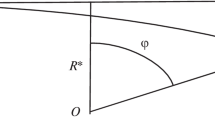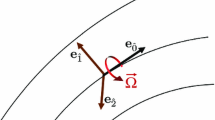Abstract
A theory of gravitational interaction in classical electrodynamics is developed on the basis of an earlier-proposed minimal relativistic model of gravitation. From the variation principle, a system of gaugeinvariant equations of the interacting electromagnetic and gravitational fields is deduced and their common energy-momentum tensor is constructed. A rigorous solution to the problem of regularizing the field mass of a point charge is given with consideration for the coupling energy of the gravitational interaction. The propagation of electromagnetic waves in the gravitational field is discussed. It is shown that, under the condition of the existing resonant ratio 2: 3 for the periods of Mercury’s orbital revolution and daily rotation, tidal forces cause a regular shift in the planet’s perihelion in an observable forward direction.
Similar content being viewed by others
References
N. N. Bogolyubov and D. V. Shirkov, Introduction into the Theory of Quantized Fields (Nauka, Moscow, 1957), p. 23 [in Russian].
H. Möller, in New Gravitation Problems, Collection of Sci. Works (Inostr. Liter., Moscow, 1961), pp. 65–84 [in Russian].
L. D. Landau and E. M. Lifshitz, Course of Theoretical Physics, Vol. 2: The Classical Theory of Fields (Nauka, Moscow, 1988; Pergamon, Oxford, 1975).
N. V. Mitzkevich, Physical Fields in General Theory of Relativity (Nauka, Moscow, 1969) [in Russian].
S. N. Sokolov, Gravitatsiya 1(1), 3–12 (1995).
A. N. Serdyukov, Gauge Theory of Scalar Gravitation Field (Gomel. Gos. Univ., Gomel’, 2005) [in Russian].
A. N. Serdyukov, Pis’ma Fiz. Elem. Chastits At. Yadra 6, 312–331 (2009).
A. Einshtein, Collection of Sci. Workds, in 4 vols. (Nauka, Moscow, 1965), Vol. 1, pp. 65–114 [in Russian].
V. A. Fok, The Theory of Space, Time and Gravitation (Fizmatgiz, Moscow, 1961; Pergamon, Oxford, 1964).
H. Reissner, Ann. Phys. (N.Y.) 50, 106 (1916).
G. Nordström, Proc. Netherlands Acad. 20, 1238 (1918).
M. A. Markov, Zh. Eksp. Teor. Fiz. 64, 1105–1109 (1973).
M. A. Markov, Preprint OIYaI R2-5289 (Dubna, 1970); Selected Works, in 2 vols. (Moscow, 2001), vol. 2, pp. 41–58 [in Russian].
W. Pauli, Theory of Relativity (Pergamon, Oxford, 1958; Nauka, Moscow, 1983).
L. Brillouin, Relativity Reexamined (Academic, New York, 1970; Mir, Moscow, 1972).
A. A. Logunov, Lectures in Relativity and Gravitation: AModern Look (Nauka, Moscow, 1987; Pergamon, Oxford, 1990).
A. L. Zel’manov and V. G. Agakov, Elements of the General Theory of Relativity (Nauka, Moscow, 1989).
D. D. Ivanenko and G. A. Sardanashvili, Gravitation (Nauka, Moscow, 2004) [in Russian].
A. N. Serdyukov, in Proceedings of the Intern. Seminar on Modern Questions of Elementary Particle Physics, Dedicated to Memory of I. L. Solovtsov (Dubna, 2008), pp. 218–227.
F. J. Belinfante, Physica A 6, 887 (1939).
L. D. Landau and E. M. Lifshitz, Course of Theoretical Physics, Vol. 1: Mechanics (Nauka, Moscow, 1982; Pergamon Press, New York, 1988), pp. 12–17.
I. M. Gel’fand, R. A. Minlos, and Z. Ya. Shapiro, Representations of the Rotation and Lorenz Group and Their Applications (MacMillan, New York, 1963; Nauka, Moscow, 1958).
D. Ivanenko and A. Sokolov, Classical Theory of the Field (Gostekhteorizdat, Moscow, 1951) [in Russian].
S. L. Shapiro and S. A. Teukolsky, Black Holes, White Dwarfs, and Neutron Stars: The Physics of Compact Objects (Mir, Moscow, 1985; Wiley, New York, 1983).
G. Nordström, Phys. Zeitschrift 13, 1126–1129 (1912).
S. Shapiro, Astrophysics, Quants and Theory of Relativity (Moscow, 1982), p. 232 [in Russian].
V. S. Avduevskii et al., Teor. Mat. Fiz. 78(1), 3 (1989).
Ch. Misner, K. Thorne, and J. Wheeler, Gravitation, vol. 3 (Freeman, San Francisco, 1973; Mir, Moscow, 1977).
V. G. Turyshev, Usp. Fiz. Nauk 179, 3–34 (2009) [Phys. Usp. 52, 27 (2009)].
Author information
Authors and Affiliations
Additional information
Original Russian Text © A.N. Serdyukov, 2011, published in Pis’ma v Zhurnal Fizika Elementarnykh Chastits i Atomnogo Yadra, 2011, No. 2(165), pp. 137–156.
Rights and permissions
About this article
Cite this article
Serdyukov, A.N. Field theoretic treatment of gravitational interaction in electrodynamics. Phys. Part. Nuclei Lett. 8, 78–89 (2011). https://doi.org/10.1134/S1547477111020117
Published:
Issue Date:
DOI: https://doi.org/10.1134/S1547477111020117




